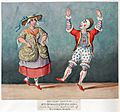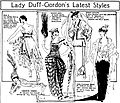Pantomime facts for kids

Pantomime, often called panto, is a super fun type of live show you usually see around Christmas and New Year. It's really popular in Britain and some other countries where English is spoken. Don't mix it up with mime, which is acting without talking! Pantomimes are known for being hilarious and letting the audience join in. While they're mostly for kids, grown-ups love them too!
Contents
The History of Pantomime Shows
Early Beginnings in Ancient Greece
Long, long ago, in Ancient Greece, there was a type of entertainment called pantomimos. This was usually a show performed by just one dancer.
Pantomime in the Middle Ages
Later, in the Middle Ages, a different kind of theatre started called Commedia dell'arte. This was a bit like modern pantomime. These shows told stories using characters that were always the same, like the lovers, the father, or the servants.
Pantomime Arrives in England
Pantomime first came to England as short performances. They were often shown between parts of longer opera shows. Over time, these short acts became full-length shows all on their own!
What to Expect at a Modern Pantomime

Today, pantomimes are a big Christmas tradition. They are shows for kids, but adults enjoy them just as much! Usually, a well-known story is told. Some popular pantomime stories include Cinderella, Jack and the Beanstalk, Pinocchio, and Snow White.
Pantomimes have lots of talking and singing. Sometimes, the audience even gets to sing along! There are many special traditions that make pantomime unique. Here are some of the main ones:
- Role Reversal: The main young hero (called the principal boy) is often played by a young woman. She usually wears tight-fitting male clothes.
- The Pantomime Dame: An older woman, often the hero's mother, is usually played by a man dressed as a woman. This is always very funny!
- Audience Participation: The audience gets to join in the fun! You might hear people shout "Look behind you!" or "Oh, yes it is!" and "Oh, no it is not!" Everyone is encouraged to boo the bad guy and cheer for the good characters.
- Silly Songs: You'll often hear a song that uses a well-known tune but has funny, new words.
- Animal Characters: An actor often plays an animal in a special costume. This is often a pantomime horse or cow. Two actors are usually inside one costume, one for the front and one for the back!
- Stage Directions: The good fairy always enters from the right side of the stage. The evil villain always enters from the left. This tradition comes from old theatre, where the right side meant "heaven" and the left meant "hell."
- Sweet Treats: Sometimes, the actors will throw sweets out to the children in the audience. They might even invite a few kids onto the stage to ask them questions.
- Water Fun: The villain might squirt water guns at the audience. Or they might pretend to throw a bucket of water that is actually full of harmless things like streamers!
- Slapstick Comedy: Pantomimes often have silly, physical comedy. This can include actors throwing custard pies in each other's faces!
- Guest Stars: Sometimes, a famous person or celebrity will be a special guest star in the show.
Related pages
Images for kids
-
The Christmas Pantomime colour lithograph book cover, 1890, showing harlequinade characters
-
Dan Leno and Herbert Campbell in Babes in the Wood, 1897, at the Drury Lane Theatre in London's West End
-
Princesses Elizabeth and Margaret in a Windsor Castle wartime performance of Aladdin
-
Styles of Lucy, Lady Duff-Gordon, used in a vaudeville circuit pantomime; sketched by Marguerite Martyn of the St. Louis Post-Dispatch, April 1918









